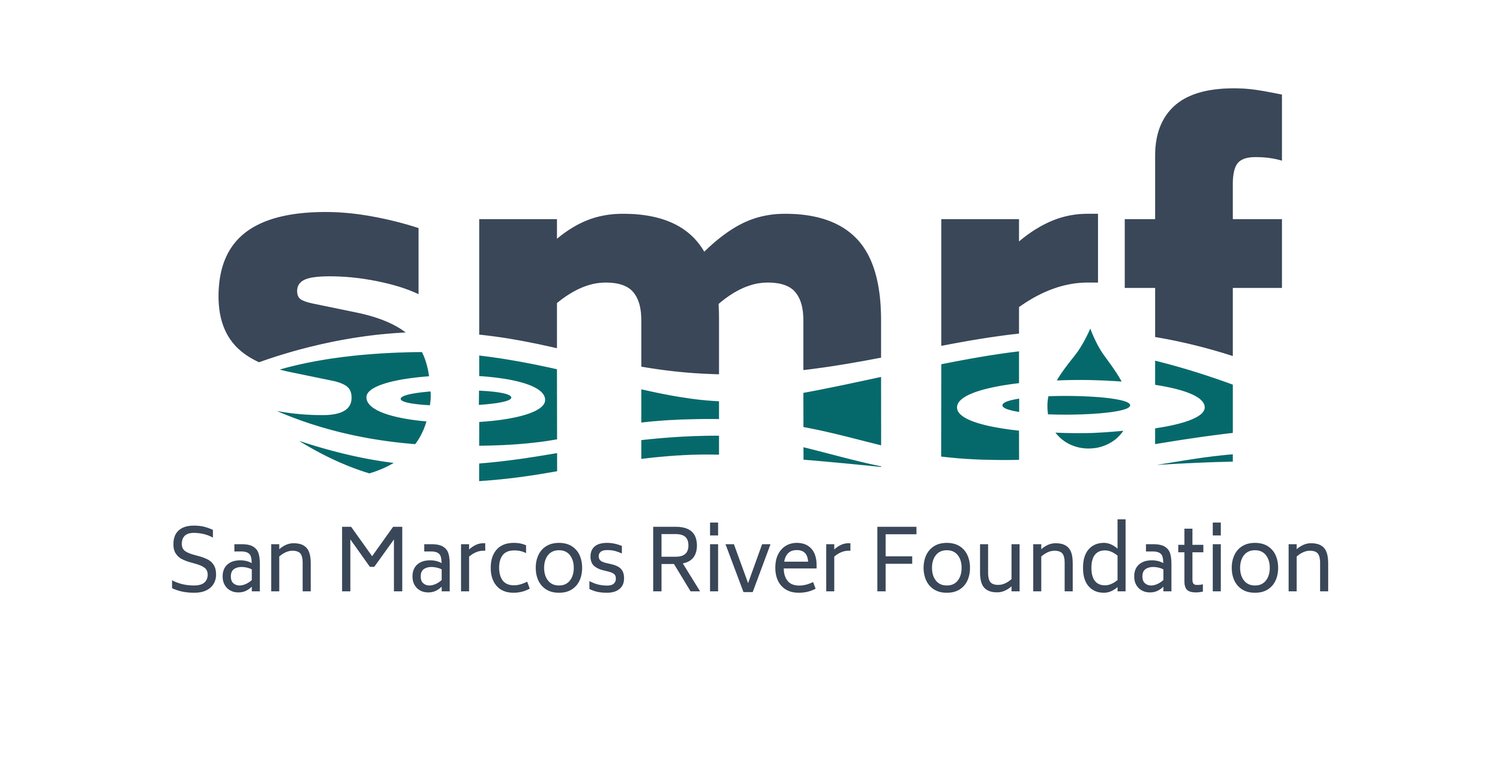
History
Founded in 1985
The San Marcos River Foundation was formed in 1985 to ensure the continued flow of the San Marcos Springs, improve water quality and protect the natural beauty of the river through the establishment of parks and habitat restoration.
Through advocacy, research, and education, SMRF addresses a wide range of issues impacting the springs and river, including responsible development in flood plains and sensitive areas around the aquifer recharge zones, non-source point pollution, and wastewater discharges. SMRF is also involved in planning for both droughts and flooding, the impact of heavy recreational use, stormwater control, and the spread of invasive species threatening habitats of endangered species found in the river.
SMRF started with annual clean-ups along the river, which has now turned into a city-wide program in collaboration with Keep San Marcos Beautiful, and education so that local residents will understand how the aquifer works and the unique species that exist both in the aquifer and river. During this period, SMRF worked to identify water quality problems and seek out solutions for improvement.
Critical Issues
-
One of the first areas identified for remediation was the waters downstream of the San Marcos wastewater treatment plant, which treated waste at the minimum standard required by the state. SMRF challenged their permit renewal and sought a permit requiring cleaner discharge. It was a long and costly fight, but SMRF prevailed. TCEQ did not want to make the permit strict enough to include the treatment of phosphorous, but after lobbying by SMRF and many local residents, the City voluntarily agreed to include phosphorous treatment in its wastewater plan.
SMRF later confronted the City on its plans to withdraw river water to dilute discharge at the wastewater plant. Often referred to as a bed-and-banks permit, treatment plants use the bed and banks of the river to transport wastewater to their water plant downstream using the river water/wastewater combination. This case, technically very complicated, went all the way to the Texas Supreme Court, which upheld the Appeals Court ruling in favor of SMRF.
-
A great deal was learned during these early years. SMRF also began researching water rights along the river, how the state regulates those, and how low the river can get during dry times with all the previously granted water rights. Lower flows, due to over-permitting and drought, would naturally affect the assimilation of wastewater, lower dissolved oxygen levels, and cause other problems downstream.
SMRF then decided to file a water rights application, purchasing water as do other permitted entities for industrial or irrigation purposes. However, SMRF would insist that their purchase be left in the river instead of pulling it out. SMRF believed this would force TCEQ to calculate how much water was actually in the river and realize that with their over-permitting, they would have to admit that they would be unable to grant SMRF's request.
This began a ten-year-long legal battle in which SMRF sued TCEQ for refusing to treat our water right like any other application. Applicants do have to specify where they would be measuring their water rights, and SMRF chose the Gulf Coast estuaries and bay since that way, the whole river would have the benefit of SMRF's water rights. Also required was a study showing that the water would not be wasted. SMRF, with its $25,000 application check, submitted the state's own voluminous study about how much water the bays required- 1.3 million-acre feet- the exact amount in SMRF's application.
Under the threat of a lawsuit for failure to handle it in a timely manner, TCEQ Commissioners hastily put it on their agenda and denied it. SMRF sued right away and won in District Court to have the application handled properly and sent to a public hearing process.
As the legal battle went on, SMRF worked with American Rivers to get the Guadalupe River declared one of the Top Endangered Rivers in 2003, bringing national publicity to our region's water problems. SMRF also worked to assemble the many stakeholders with a clear interest in freshwater reaching the coast, where among other things, the whooping cranes winter and depend on freshwater in their feeding grounds. Many foundations, birding groups, fishing and shrimping coalitions, and other river groups statewide also began filing applications for in-stream rights or supported SMRF's.
With a new focus on water availability, an overload of requests for in-stream rights, and entities like GBRA concerned about the ramifications of SMRF's water rights application, the legislature eventually handled the matter by passing a retroactive law saying TCEQ could not grant a new "in-stream" water rights to anyone unless it was a conversion from an existing water right granted for irrigation or industry.
The law passed by the Legislature as a result of SMRF's case, however, did create the SB3 process or the Bay/Basin Stakeholder process where citizens from different "silos" representing farmers, fishermen, cities, counties, and environmental groups and all other interested parties, gather to appoint a science team to review all scientific evidence regarding water needs in rivers and bays. SMRF represents our region on the Bay/Basin Stakeholder process and sits on the committee that chooses the scientific studies designed to simply determine how much water Texas rivers should be allowed to have, how much should go to bays, what are minimum flow levels and how much water is needed to maintain a healthy eco-system.
-
SMRF has served on the City Comprehensive Plan committee and follows all P&Z and City Council meetings to follow development and transportation plans closely to quantify the impact they might have on the river.
SMRF has supported litter control projects in the parks, improved public access, advocated for more green space to mitigate flooding issues, and helps educate and alert the public and local officials to potential threats to the river and how best to tackle them. In addition, SMRF has worked with landowners downstream to resolve issues involving the tubing companies and large numbers of recreational tubers behaving poorly and leaving behind lots of trash. Currently, SMRF is focused on downstream development, wastewater effluent treatment standards, and development and regulatory policy in the recharge zones.
Activities & Partners
-
SMRF has provided volunteers and assisted in many studies conducted by both TPWD and USFWS, from wild rice counts and habitat restoration projects to a recreational tube count on both the upper and lower San Marcos to gauge the actual numbers. Starting in 2004, SMRF served on the TPWD River Conservation Advisory Board and continues to work closely with them.
-
In 2005, SMRF began participating on the steering committee of the first Watershed Plan in the state of Texas to develop a recovery plan for the highly degraded and contaminated Plum Creek watershed, which consists of many branches but eventually flows into the San Marcos River at Luling. The recommendations are being put into effect now, but progress is slow. Chicken farms continue to dump their waste directly into creeks, and TCEQ regulations allow the city of Kyle to dispose of sewage in a less-than-ideal manner and concentration. However, the program has been very successful in its feral hog eradication program, has received grants to clean up Nonpoint Source Pollution, has implemented a water quality monitoring program, and started regular clean-ups.
-
SMRF is represented on the steering committee of the Watershed Initiative, which the Meadows Center is coordinating. In its final stages, it will be presented to TCEQ and the EPA soon and, once approved, opens the way for grants and projects to protect water quality in and around San Marcos. One of the major components of this plan will be land conservation in critical recharge areas which coincides with SMRF's own plans for protecting the watershed.
-
In 2005, a stakeholder process began to preserve the aquifer, its springs, and the watersheds that serve it- attempting to balance anticipated population growth and increased pumping with community needs and allowing recreation to continue on the rivers. After ten years, a large stakeholder group covering interests from Del Rio to Austin has begun implementation of a broad-based and multi-faceted plan to encourage conservation, restore native habitats, improve banks, and protect and plan for threats to endangered species. SMRF has worked extensively with the HCP process and continues to participate in its implementation.
-
A SMRF representative serves on the Region L Planning Board, which includes cities and counties from the coast to San Antonio, including San Marcos and Hays County. The Board works for 5 years on a regional water plan that is presented to the Texas Water Development Board for approval. Water projects which want state monies have to be on the plan for consideration and are ranked by the Region L Board.
-
A statewide water quality monitoring organization, SMRF has partnered with Stream Team for over 30 years to provide water quality data on the San Marcos River. River Ranger volunteers test 30 sites from Spring Lake to Fentress and serve as an early warning system for potential water quality problems and help better understand the river's health and cycles.
-
SMRF was one of many proud sponsors of the award-winning documentary, Yakona, a visual journey from the perspective of the river.
-
SMRF works with the Meadows Center on various regional water issues and partners with them for invasive plant removals on and around Spring Lake
SMRF works with many other groups to ensure the San Marcos River remains clean and healthy. These include: the San Marcos Greenbelt Alliance (SMGA), the Hill Country Alliance, the Hill Country Network, the Greater Edwards Aquifer Alliance (GEAA), the Comal Conservation Alliance (CCCA), the Great Spring Project (GSP), the Eyes of San Marcos, Keep San Marcos Beautiful, and the Discovery Center.
